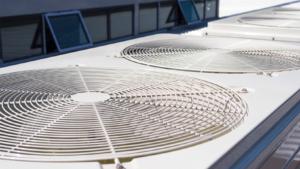As the state’s year-end deadline approaches for developing a framework to decarbonize buildings, various professionals are trying to determine how the resulting legislation could impact commercial real estate companies.
For months, the state’s climate consultant, Energy and Environmental Economics (E3), has conducted an in-depth analysis of building decarbonization scenarios to determine which scenario could meet Maryland’s greenhouse gas (GHG) reduction mandate at the lowest cost. This summer, E3 presented preliminary study results that favor electric-only mechanical systems in new construction and dual-fuel systems (such as combining an electric heat pump with a backup, gas-fired system) in existing buildings.
 “Decarbonizing existing buildings can be complicated and costly,” said Brian Krug, Vice President of Engineering for Fidelity Mechanical Services.
“Decarbonizing existing buildings can be complicated and costly,” said Brian Krug, Vice President of Engineering for Fidelity Mechanical Services.
Small buildings present the easier opportunities to switch to dual fuel.
In buildings smaller than 10,000 square feet with split systems or packaged systems “up to 20 tons, it is feasible and easy to convert to a hybrid system,” Krug said. “But when you get into larger buildings over 30,000 square feet per floor, electrification isn’t the preferred option… Current manufacturer offerings that would satisfy the state’s recommendations are limited therefore building owners would need to consult companies like Fidelity Mechanical Services to engineer a hybrid system.”
“Current technologies like variable refrigerant flow (VRF) systems present opportunities to create highly efficient hybrid systems even in larger, more challenging buildings because VRF lines are small and the retrofits tend not to be very invasive,” said Richard Ellison, Senior Energy Engineer at MD Energy Advisors. Ellison pointed to the example of a retrofit of an historic post office building that was more than 100 years old. That project utilized water-cooled VRF systems and roof mounted photo-voltaic (PV) arrays to earn LEED certification, reduce greenhouse emissions and maintain the historic appearance of the building.
For a VRF system to be an attractive option, however, “the geometry plays an important role in the performance, cost effectiveness and energy efficiency of the technology,” Krug said. “Buildings that are long, narrow, and rectangular in shape offer no interior heat source to transfer to the exterior zones to offset skin heating losses. A VRF system utilizes heat that is generated within the interior zones of the building by lights, computers, people and transfers that to the exterior zones of the building. In addition, VRF is an expensive technology. First costs, operating and energy costs, and energy efficiency must be evaluated on a case by case basis and compared to standard systems to determine if attractive payback on investments are present.”
Migrating to a hybrid system raises other considerations for building owners.
“Dual-fuel could be problematic and costly, because it may require an owner to maintain multiple systems,” Ellison said. Some systems, such as VRF, have different maintenance requirements from a traditional system using a boiler and a chiller “because you are pumping refrigerant throughout the building as opposed to distributing air, chilled water and hot water.” The maintenance of different types of systems may require new skill sets and training for maintenance personnel.
Converting to dual fuel could be especially cumbersome in a multi-tenant building that has separate systems for each tenant. The building owner might have to install multiple heat pumps and set aside additional space to house that equipment and contain the noise from the compressors.
In addition to the cost of adding units or engineering customized systems, the owner would also face significantly higher energy costs.
“The cost per BTU of natural gas is so much cheaper than electric,” Krug said. “Gas-fired systems provide a more attractive payback than electrified systems. In addition, heating energy costs associated with electrified heating systems will likely be much higher when compared to natural gas heating systems.”
For companies like Merritt Properties, the dual-fuel proposal generates numerous concerns.
“Our single-story product, which is our typical light industrial building with some office component and a packaged rooftop unit, is probably the easiest to convert,” said Joshua Asbury, Vice President, Development and Construction at Merritt. “But there isn’t any payback in doing that conversion. We already put in the highest rated, energy-efficient rooftop units that run off gas. So there is no energy savings potential and gas heat is less expensive.”
Merritt has installed VRF systems in some of its larger buildings and likes the technology even though the upfront and maintenance costs are higher, Asbury said. Converting other multi-story buildings would be costly and would also fail to generate payback.
Building owners would need to consider an additional possible expense in converting buildings to dual fuel, namely would they need to upgrade the electrical service to their buildings to support the additional load, he said. The state would need to consider all of those expenses while developing any grant program to incentivize CRE owners to retrofit their buildings.
With a General Assembly debate about legislation to decarbonize buildings expected to begin in early 2022, property owners will need to educate themselves about the options presented and the ramifications for their businesses, said Jared Lyles, Energy Engineer at MD Energy Advisors.
“This is a very complicated issue” Lyles said. “I think the better educated everyone is – building owners, specifically – then the better equipped we will be going forward.”